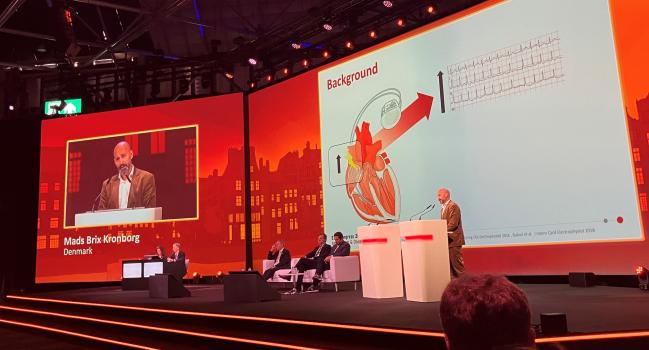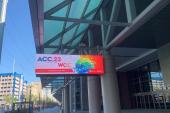DANPACE II: Reducing Atrial Pacing Doesn’t Prevent AF in Sinus Node Disease
The trial settles one question in the field, but the optimal pacing rate warrants further study, experts say.

AMSTERDAM, the Netherlands—In patients with sinus node dysfunction treated with dual-chamber pacemakers, minimizing atrial pacing doesn’t lower the likelihood of developing atrial fibrillation (AF) and is potentially harmful, the DANPACE II trial shows.
The proportion of patients who had an AF episode lasting more than 6 minutes detected during follow-up was 46% regardless of whether their devices were programmed to a base rate of 40 bpm (without rate-adaptive pacing) or to a base rate of 60 bpm (with rate-adaptive pacing), Mads Brix Kronborg, MD, PhD (Aarhus University Hospital, Denmark), reported recently at the European Society of Cardiology Congress 2023.
The findings, published simultaneously online in the European Heart Journal, also showed no difference between groups in quality of life or functional capacity, although the patients treated with a lower pacing rate were significantly more likely to develop presyncope or syncope.
Kronborg noted that AF is common in patients with sinus node disease, and that some observational studies have identified a link between a higher percentage of atrial pacing and a greater risk of AF. Whether that relationship is causal, however, isn’t clear.
Now, DANPACE II has shown that minimizing atrial pacing, at least at the threshold tested, doesn’t seem to help, and that pacing at a base rate of 60 bpm with rate-adaptive pacing prevents presyncope and syncope. Since that’s the standard rate used by physicians, the trial “doesn’t change our clinical practice,” Kronborg said at a press conference.
Still, some selected patients may require a lower pacing rate. “There are some patients who—especially when they are at rest—they feel their heart, and if they’re used to [having] a lower pulse of 40, they might . . . have discomfort or chest pain when you program it to 60. And for those patients, I would individually reduce it to a lower base rate,” he said, adding that he would discuss bumping it back up in response to any signs of presyncope or syncope.
The DANPACE II Trial
DANPACE II, conducted at 11 Danish centers, included 539 patients (mean age about 73 years; 50% women) who had sinus node dysfunction, were set to receive a dual-chamber pacemaker, and were free of permanent/persistent AF, bradycardia, and chronotropic incompetence; 44% had a history of AF.
The median percentage of atrial pacing was just 1% in the patients randomized to a base rate of 40 bpm without rate-adaptive pacing and 49% in those randomized to the higher base rate with rate-adaptive pacing (P < 0.001).
That difference didn’t translate into a difference in the detection of AF lasting more than 6 minutes during a median follow-up period of 2 years (P = 0.83), which was consistent across subgroups defined by age, PR interval, prior AF/atrial flutter, and sex.
There also were no significant differences between pacing groups when looking at AF episodes lasting more than 6 hours or more than 24 hours.
The main safety endpoint, presyncope or syncope, however, occurred more frequently among patients at the lower pacing rate (22% vs 13%; P = 0.01).
In addition, crossover was much more common among patients initially randomized to an atrial pacing rate of 40 bpm (23% vs 3%). The main drivers of having devices programmed to a higher pacing rate after randomization were chronotropic incompetence (61% of crossovers) and presyncope or syncope (29%).
Optimal Pacing Rate Needs Further Study
Serving as a discussant following Kronborg’s presentation, Jose Merino, MD, PhD (La Paz University Hospital, Madrid, Spain), noted that there is the potential for atrial pacing to have both positive and negative effects on atrial arrhythmias. On the positive side, higher atrial pacing rates have been associated with shorter atrial refractoriness, less compensatory adrenergic tone, and suppression of pauses and ectopic beats, which may prevent short-long activation sequences, he said.
On the negative side is an association between atrial pacing and prolongation of atrial conduction and global activation times. It may also shorten the device’s battery life and potentially limit the use of certain medications that are common in patients with sinus node disease.
Although there are some open questions after DANPACE II, including whether the results are driven more by the pacing mode or the pacing rate, the trial shows that “programming intended to minimize atrial pacing should not be used as a routine in unselected patients with sinus node dysfunction,” Merino said. “This study, however, warrants further investigation about the optimal pacing rate to minimize atrial fibrillation and syncope in this population.”
Rate-adaptive pacing makes sense, and extra measures to minimize atrial-based pacing do not have a big impact. Kalyanam Shivkumar
Commenting for TCTMD, Kalyanam Shivkumar, MD, PhD (UCLA Health, Los Angeles, CA), editor-in-chief of JACC: Clinical Electrophysiology, said DANPACE II “settles one unanswered question in the field, and I believe it is good to have this question answered.” Prior to this, there was a lack of evidence to guide the programming of pacemakers in this population, he added. “The trial clearly provides us the answer for that particular set of patients.”
Which patients may still benefit from minimization of atrial pacing remains to be characterized in future studies, Shivkumar said.
But for now, he said, the take-home message is that “rate-adaptive pacing makes sense, and extra measures to minimize atrial-based pacing do not have a big impact.”
Todd Neale is the Associate News Editor for TCTMD and a Senior Medical Journalist. He got his start in journalism at …
Read Full BioSources
Kronborg MB, Frausing MHJP, Malczynski J, et al. Atrial pacing minimization in sinus node dysfunction and risk of incident atrial fibrillation: a randomized trial. Eur Heart J. 2023;Epub ahead of print.
Disclosures
- DANPACE II was funded by Independent Research Fund Denmark, the Danish Heart Foundation, Karen Elise Jensen’s Foundation, Arvid Nilssons Foundation, and the Danish Pacemaker and ICD Registry. Biotronik, Boston Scientific, Medtronic, and St. Jude Medical sponsored remote monitoring during the study period.
- Kronborg reports a speaking fee from Abbott.
- Merino reports research contracts from Medtronic and speaking, educational, and advisory board fees from Abbott and Microport.





Comments